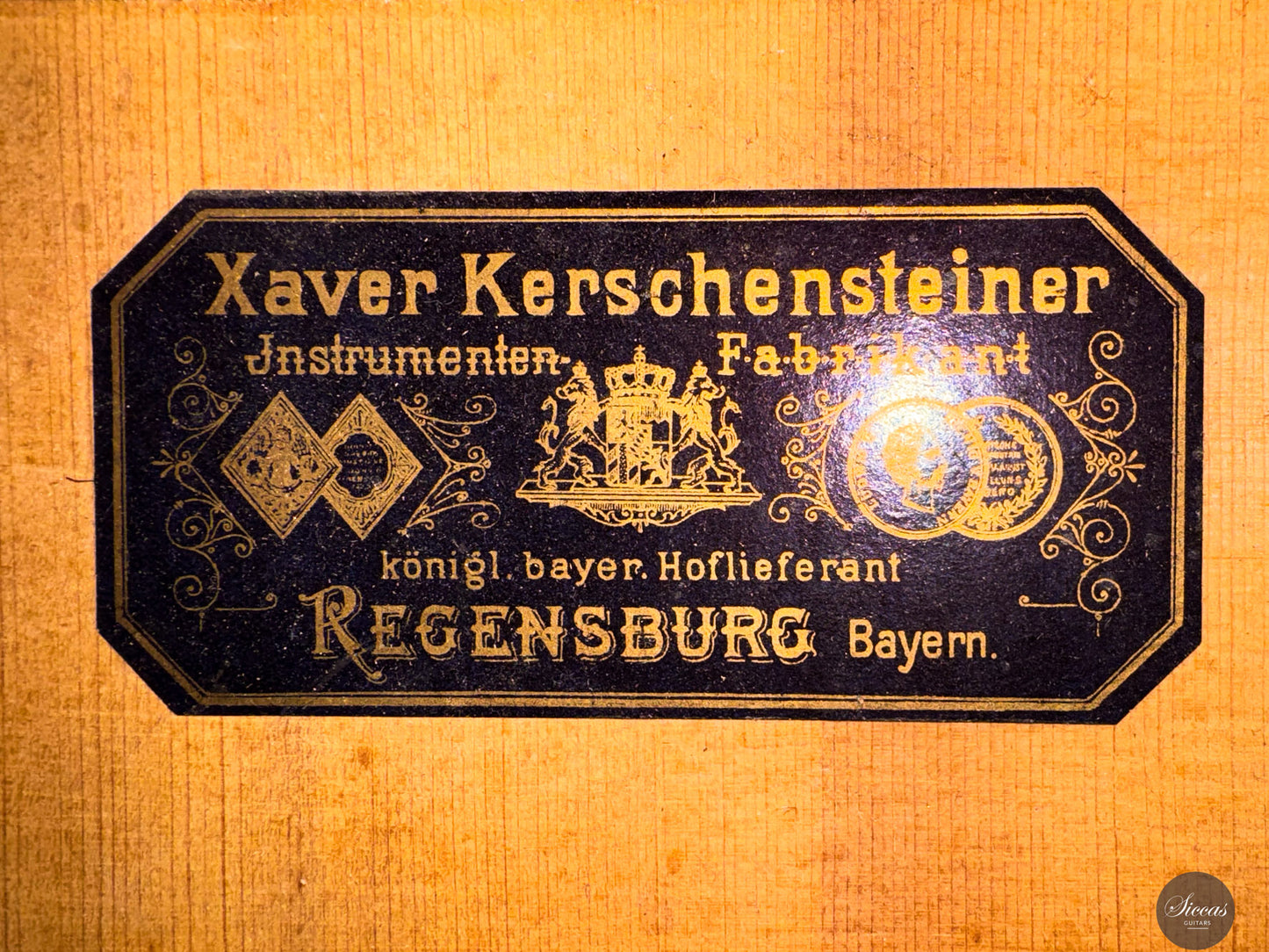Franz Xaver Kerschensteiner - ca. 1900 - 62 cm
Franz Xaver Kerschensteiner - ca. 1900 - 62 cm
Details
Details
Overview
Overview
Shipping important note
Shipping important note
Delivery times are typically reliable and most instruments arrive within the estimated timeframe.
Should any unexpected delay occur, our team will keep you informed and provide support at every step. For all shipping details and exceptions, please see our Shipping Policy.
Details about GPSR
Details about GPSR

























Video overview


More details about the guitar
About the luthier
Franz Xaver Kerschensteiner (1839–1915) was a German luthier renowned in Regensburg for his versatility in instrument making, especially zithers, violins, and guitars. He trained under violin maker Petrus Schulz and undertook a traditional journeyman’s pilgrimage to leading workshops across Europe, including Munich, Linz, Vienna, and Würzburg. Over his career, more than 5.000 instruments were crafted in his workshop. He received numerous honors and held the prestigious title of “Royal Bavarian Court Supplier”.About the guitar
This Romantic guitar, attributed to Kerschensteiner and dating from around 1900, is a fine example of his work in the Viennese or early Romantic tradition. Built in traditional style, strikingly well preserved for its age, it retains a spruce soundboard paired with birdseye maple for back and sides, echoing the aesthetic elegance seen in his similarly styled instruments.The instrument remains in very good condition, with only two well-repaired and stable cracks on the top, and remarkably few signs of wear given its age. It produces a surprisingly soft, rich tone with an intimate, somewhat boxy character. The resonance is notably strong in the mid and lower registers. Equipped with precise friction pegs, it offers accurate tuning and maintains historical authenticity.
The air-body resonance, tuned between C sharp and D, contributes to warmth and responsiveness that suit romantic repertoire exceptionally well. Overall, it stands as an excellent, playable representation of early Romantic guitars, combining refined craftsmanship with expressive tonal design.
Regular care extends the life of the instrument
Even with careful use, a classical guitar may gradually change in appearance or respond to unstable storage conditions. Have a close look at your guitar regularly and be attentif to changes. If your instrument is suffering from its environement, it will let you know.
Protect Your Guitar: Handle with Care
Be mindful when touching your instrument with greasy or unwashed hands: any skin contact is a small attack on the varnish. Of course, a guitar is made to be played, but taking a few precautions helps preserve its beauty: wash your hands before playing, wear long sleeves, and avoid unnecessary direct skin contact with the body of the instrument.
Pro tip: Avoid playing with a button-up shirt, heavy jewelry, or a belt, as these can scratch the guitar. Also, make sure your guitar case is free of any objects that could damage the instrument during storage.
String care
A good habit to adopt is wiping down your strings briefly after each playing session. This small action significantly extends their lifespan and helps maintain a consistent, comfortable feel under your fingers.
Most importantly, clean strings are essential for keeping your instrument in tune. Corrosion, sweat, and dust can affect the uniformity of the strings and interfere with accurate tuning across the entire fingerboard.
Pro tip: If you're having trouble getting your guitar in tune, it might be time to change the strings. A useful test is to compare the pitch of the 12th fret harmonic with the fretted note at the 12th fret; if there's an unusually large gap between them, your strings may have lost their integrity and should be replaced.
Keep Your Shellac Finish Shining!
Got a guitar with a shellac (French polish) finish? Here's a simple trick: Take a clean microfiber cloth and gently breathe on the surface to create a light mist. Then, softly rub to remove fingerprints, sweat, and grease. That’s usually all it takes to keep it looking great, no products needed!
Pro tip: Every few years, treat your guitar to a check-up with a luthier to keep it in top shape.
Storing Your Guitar: Climate Matters
Your guitar can safely stay outside its case, as long as the surrounding environment maintains 42–55% humidity and a temperature between 18–25°C.
Keep in mind that humidity levels can still fluctuate inside the case, especially during seasonal changes.
- Too much humidity may cause overtightened strings and a dull tone.
- Too little humidity can lead to a bulging top, string buzz, or even cracks.
Avoid placing your guitar near radiators, air conditioners, or windows with direct sunlight.
Pro tip: Always close your guitar case while playing. This helps preserve a stable microclimate inside the case, so your instrument is protected the moment you put it back in.





















































